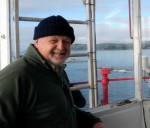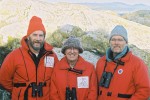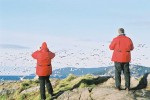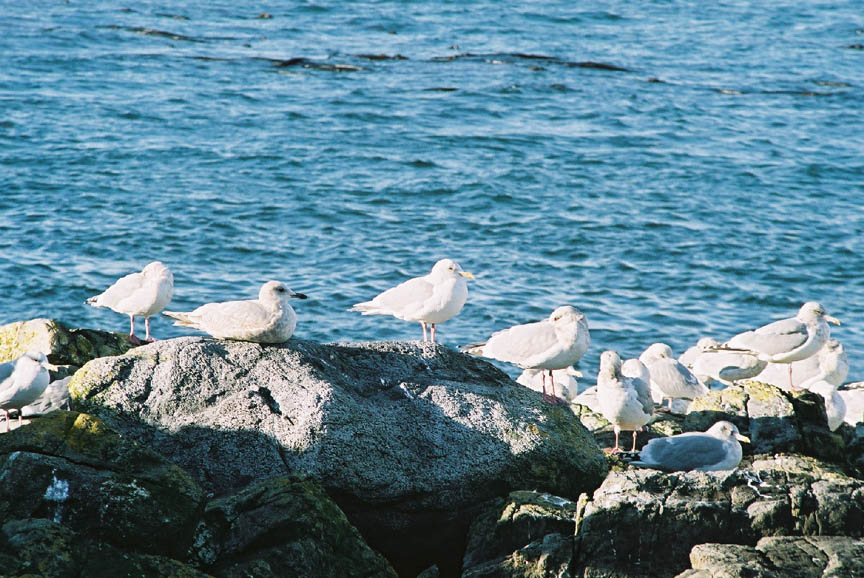Ecological Reserve and Marine Protected Area
OPERATIONAL PROPOSAL 2001/2002
 Presented to:
Presented to:
Department of Fisheries and Oceans
Attention: Dick Carson,
Director, Pacific Region
February 15, 2001

The Department of Fisheries and Oceans has recently recognized the ecological value of this treasured eco-system by selecting Race Rocks as one of the first Pilot Marine Protected Areas under the Oceans Act. Since 1980 when the Race Rocks Ecological Reserve was established, marine life on the rocky outcrops and the ocean floor extending to a depth of 20 fathoms has been protected by the Province of British Columbia. Great Race Island is home to the Race Rocks light station. Since 1980 the light- keepers have been of great assistance in protecting the Ecological Reserve by keeping a watchful eye.
As a consequence of a Federal decision to de-staff the light station in 1997, the keepers were to be removed and they would no longer provide the essential supervision required for full protection of the Reserve. In excess of $25 million worth of commercially exploitable species are known to exist within the Reserve area. The presence of the keepers was determined to be essential for continued protection. Coast Guard agreed to a special short-term agreement whereby Pearson College would retain the former light keepers as eco-guardians and operate the surplus facilities as a new Marine Education Centre until such time as a permanent solution for the operation of Race Rocks could be found.
A New Beginning
The Federal Department of Fisheries and Oceans began community consultations in 1998 to assess the possibility of Race Rocks being recognized as Canada’s first Marine Protected Area. For the first time, Race Rocks, with the cooperation of both levels of government would be truly protected with a management plan that included both the Provincially managed Ecological Reserve and the Federally controlled water column.
On September 14, 2000 the Minister of Fisheries and Oceans, the Hon. Herb Dhaliwal, announced he had accepted the recommendations of the Race Rocks Advisory Board and DFO staff and Race Rocks would become Canada’s first Marine Protected Area.
Background
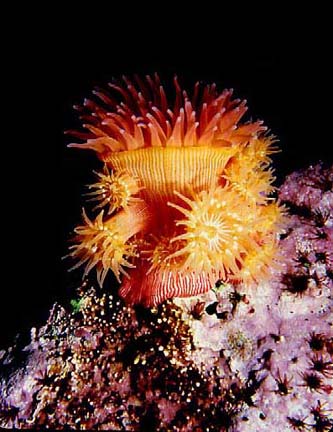 An extensive management plan for the Race Rocks area is now being developed by DFO staff working in close consultation with BC Parks and representatives of the South Island First Nations. At the invitation of the MPA strategy, extensive community involvement has led to broad consultation and local support for the MPA initiative.
An extensive management plan for the Race Rocks area is now being developed by DFO staff working in close consultation with BC Parks and representatives of the South Island First Nations. At the invitation of the MPA strategy, extensive community involvement has led to broad consultation and local support for the MPA initiative.
For the first time, the Race Rocks eco-system will enjoy full protection under a unified management plan with the authority of both the Federal and Provincial governments. An important new provision has also been made for the full involvement of First Nations in on-going management of the area. The vital priorities of protecting ecological values, education and research are the primary focus of the new plan now being developed.
Scope of the Race Rocks Project
For the past four years, on a temporary basis to assure interim protection at Race Rocks, Pearson College staff and students have undertaken the following responsibilities:
Protection
- Continuous supervision of the island and Reserve by resident eco-guardian.
- Security for buildings, equipment and infrastructure (24 hrs/day all year).
- Vigilant observation of activities within the Reserve and if needed, reporting of infractions to appropriate agencies.
- Electronic video monitoring of the Reserve area by enforcement agencies.
- Restrict access to specific areas as necessary.
Safety
- Observe and report any situations which may represent a safety hazard.
- Assist individuals in distress when required and liaise with rescue agencies.
- Assist in emergency communications.
- Be vigilant for fire hazards.
- Monitor for the occurrence of hazardous material spills.
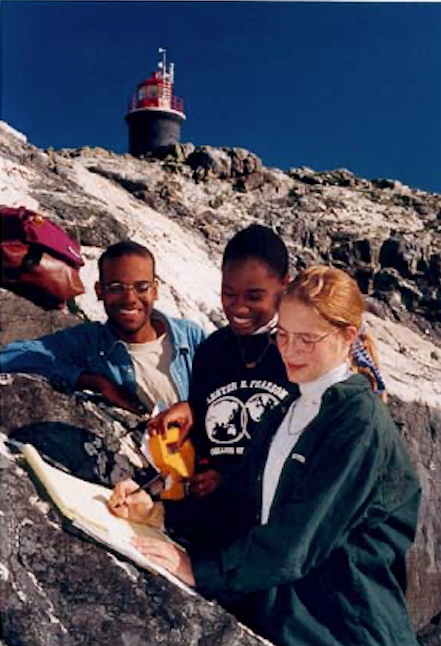 Science
Science
- Continue monitoring program for weather conditions.
- Continue monitoring program for seawater temperature and salinity.
- Ongoing protection of unique Northern Abalone populations and monitoring of population and growth rates.
- Annual intertidal and subtidal transect site monitoring.
- Installation of environmental scan sensor arrays for air, soil and seawater with full accessibility on the Internet.
- Observation and recording of marine mammal and bird populations.
- Daily ecological events log.
- Support for visiting scientists.
- Development of alternative energy solutions.
Education
- Development of curriculum materials for K-12 use.
- Cooperative development of information about First Nations focusing on the history of traditional uses and creating a supporting curriculum.
- Operation and continuous upgrading of the racerocks.com education site with a major commitment for the production of online archived video for classroom and public use.
- Interactive web cast production and delivery for use by schools, science centres, museums and conferences.
- Public education programs for visitors to the Race Rocks area.
- Education programs in cooperation with eco-tourism industry and dive community.
Eco-guardian / Project Management BC Parks, which now owns Great Race Island is issuing a long term Parks Permit to Pearson College staff to operate the site and serve as eco-guardians.
Located 3.7 nautical miles from Pearson College’s docks at Pedder Bay, Race Rocks is within easy reach in moderate weather conditions. In addition to the Race Rocks station boat, Pearson College operates two purpose built aluminum workboats suitable for transporting fuel, personnel, equipment and supplies to Race Rocks.
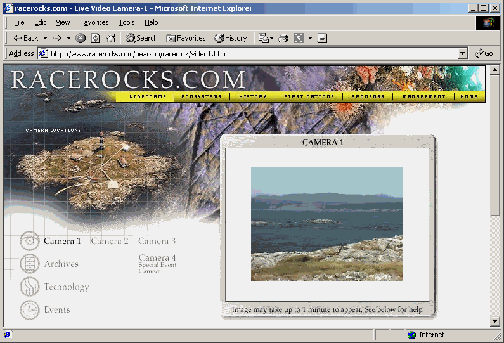 Pearson College staff provides all logistical support required for the efficient operation of Race Rocks. Qualified staffing for maintenance, accounting, purchasing and deliveries are all coordinated by existing College systems. Mike and Carol Slater, the former light-house keepers, are now employed by Pearson College and they live at Race Rocks. They are particularly well qualified to supervise and operate the facility after 30 years of experience with the Coast Guard and extensive experience observing marine life. Over the past 14 years they have been responsible for dealing with the public in the Reserve area and, when necessary, reporting infractions to the appropriate agency. Many of the College’s suppliers such as Nixon Electrical Services, Day’s Welding, Aramark Services, Henning’s Plumbing and others offer their services to Race Rocks at reduced rates or by donation.
Pearson College staff provides all logistical support required for the efficient operation of Race Rocks. Qualified staffing for maintenance, accounting, purchasing and deliveries are all coordinated by existing College systems. Mike and Carol Slater, the former light-house keepers, are now employed by Pearson College and they live at Race Rocks. They are particularly well qualified to supervise and operate the facility after 30 years of experience with the Coast Guard and extensive experience observing marine life. Over the past 14 years they have been responsible for dealing with the public in the Reserve area and, when necessary, reporting infractions to the appropriate agency. Many of the College’s suppliers such as Nixon Electrical Services, Day’s Welding, Aramark Services, Henning’s Plumbing and others offer their services to Race Rocks at reduced rates or by donation.
It is an extraordinary legacy of the Millennium Partnership Fund and our partners that Race Rocks is the most technologically advanced Marine Protected Area in the world. The state of the art information technology system includes a full island network, wireless technology, remote controlled live video streams from above and below water and an environmental data array all streamed live on the Internet for public use. Major sponsorships from Apple, Apple Learning, LGS Group, Sorenson, Sony, Telus, Yamaha, Seapoint Sensors, the Vancouver Aquarium and others support the Race Rocks project.

As an educational institution Pearson College applies significant educational resources to the Race Rocks project. Environmental Systems/Biology faculty member Garry Fletcher serves as Educational Director of the Race Rocks program. Supported by students involved in web design, scuba diving, vessel operation, photography, video production, research and school program delivery, Garry has established an award winning education program at Race Rocks. This program is widely used by educational institutions such as the Open Learning Agency, primary and secondary schools, universities, museums and science centres throughout Canada. In the past year alone there have been over 65,000 visitors directly to the racerocks.com site and thousands more through links to the Apple Learning Exchange site.
This project has proved conclusively that there can be mass electronic public access to a protected area without the negative impact of large numbers of visitors to the islands. Race Rocks provides a viable alternative to the potentially high impact personal site visit. Rather than a Marine Protected Area being a secret resource this approach encourages public education and appreciation of the area while maintaining a high level of protection.
Pearson College has a proven record of successful fundraising for the Race Rocks project. Since 1997 over $280,000 has been raised from private donors to operate Race Rocks. This was an emergency initiative to save the site from demolition while a long-term solution could be found. Pearson College will continue this commitment to fundraising for the project by raising one third of the annual operating costs for the ongoing operation of Race Rocks.
Community Commitment
Federal Fisheries Minister The Hon. Herb Dhaliwal and BC Environment, Lands and Parks Minister The Hon. Joan Sawicki committed their respective governments to the establishment of a Marine Protected Area at Race Rocks on September 14, 2000. Their action was based on the unanimous recommendations of the Race Rocks Advisory Board. The Advisory Board includes senior staff from the Department of Fisheries and Oceans, BC Parks and South Island First Nations leadership. In addition there is broad public representation from groups such as sports fishers, the dive community, ecotourism companies, marina operators, scientists, Friends of Ecological Reserves, Georgia Strait Alliance, and the Canadian Parks and Wilderness Society. A key feature of the Race Rocks Advisory Board conclusions is a recommendation that both the Federal and Provincial governments provide financial support for the Race Rocks Marine Protected Area.
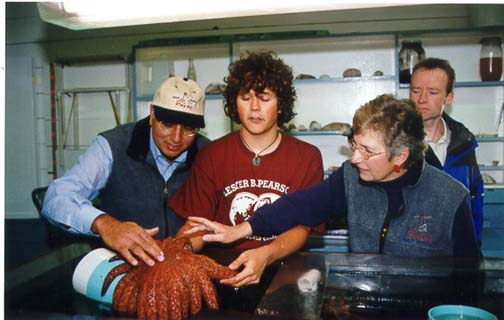
Meeting DFO Needs at Race Rocks
Race Rocks represents a unique challenge for DFO if it is to meet the declared objectives of protection, sustainability, education, research and broad community collaboration as defined in the MPA strategy. As the lead agency in the establishment of Canada’s first MPA, the Department must meet these objectives in a coordinated, cost effective manner. Pearson College, through a contract with DFO, can deliver programs under the direction of DFO that meet the defined objectives and fulfill specific DFO areas of responsibility.
The following key DFO objectives would be fulfilled under this contract:
-
- 24 hour on site staffing throughout the year
- monitoring of visitors to the MPA to ensure use guidelines are respected
- data collection on the daily number of vessels and visitors within the MPA
- reporting and recording of any infractions that may occur
- vigilant reporting of any evidence of toxic contaminants
- periodic marine mammal and sea bird population counts
- ongoing intertidal and subtidal marine life inventories
- underwater data collection through environmental scan sensors
- maintaining a daily environmental journal
- support for visiting researchers
- maintaining a directory of all research data and publications
- continuation of seawater and salinity measurements for IOS
- continuation of weather reporting for Environment Canada
- assistance to Coast Guard staff when required
- development of web based educational curriculum materials
- extensive educational programming for educational institutions and the general public utilizing the Internet as much as possible
- education programs for reserve users and liaison with commercial users
- development of specific First Nations curriculum featuring the history of traditional uses in cooperation with local band leadership
- education programs for First Nations youth including material in their own languages
- showcasing the value of MPAâs with custom live web casts for DFO events and conferences
- assisting in maintaining and enhancing vital community relationships
- ongoing involvement in the Race Rocks Advisory Board
Why is the need for Race Rocks funding special?
Race Rocks is a unique Provincial asset with specific circumstances that qualify it to be deserving of a special funding allocation designated at the Ministerial level.
Race Rocks is:
- an internationally recognized Marine Protected Area established jointly by the Federal and Provincial Governments.
- Canadaâs first and only Marine Protected Area and therefore success is essential if others are to follow.
- the Race Rocks Marine Education Centre has over $650,000 in physical building and equipment assets which clearly require security and routine maintenance.
- over $25 million worth of extremely marketable sea-life that has prospered under 20 years of protection would be subject to immediate poaching without the presence of the resident eco-guardians.
- Race Rocks has the most comprehensive accumulation of scientific data of any protected site on the West Coast. The continuous data chain, some of which dates back to 1926 must be sustained.
- Race Rocks, through award winning web based education programming, is recognized as a word leader in environmental monitoring and education delivery.
- partnerships with educational institutions such as schools, museums, science centres, and Ministries of Education provide direct benefit to Canadians.
- the funding formula proposed is in accordance with recommendations of the Race Rocks Advisory Board and the intent of the MPA strategy.
- DFO investment in Race Rocks will be directly matched at a two to one ratio by other independent funding sources.
- when gift in kind contributions from our other sponsors are considered the ratio of private contribution is over ten times the DFO contribution level.
- the involvement of DFO assures the project of stable funding. The lack of involvement by DFO will lead to immediate financial collapse.
Financial Proposal
The following operational budget provides details of projected minimum operational expenses at Race Rocks for the period April 1, 2001 to March 31, 2002. The budget is based on our four years of experience in funding the Race Rocks project and the highly efficient operational format we have established. Pearson College guarantees to cover any cost over runs if they should occur.
It is proposed that the Department of Fisheries and Oceans, BC Parks, and Pearson College each contribute $50,000 to cover the 2001-2002 operating budget.
|
Race Rocks MPA/ER
|
|
Operating Budget April 1, 2001 to March 31, 2002
|
|
|
|
|
|
Salaries
|
|
|
Eco-guardian(s)
|
42,000
|
|
Educator (1/2 time)
|
30,000
|
|
Shoreside support (1/3 time)
|
14,000
|
|
Benefits
|
9,460
|
|
95,460
|
|
|
|
Fuel
|
|
|
Generator
|
11,000
|
|
Heating
|
1,400
|
|
Boat
|
1,750
|
|
Lube/oils
|
2,000
|
|
16,150
|
|
|
|
Maintenance
|
|
|
Buildings
|
6,000
|
|
Generators
|
4,300
|
|
Water pumps
|
2,100
|
|
Desalinator
|
2,200
|
|
Winches
|
800
|
|
Boat and motor
|
4,700
|
|
Jetty
|
400
|
|
Fuel system
|
450
|
|
Radios
|
200
|
|
Diving equipment
|
2,500
|
|
23,650
|
|
|
|
Administration Costs
|
|
|
Phone
|
600
|
|
Insurance
|
1,800
|
|
Stationery/printing
|
1,150
|
|
3,550
|
|
Education Program
|
|
|
Classroom materials
|
4,500
|
|
Communication/outreach programs
|
2,500
|
|
First Nations’ program
|
5,000
|
|
Internet access
|
2,000
|
|
14,000
|
|
|
|
Total expenditures
|
$152,810
|
Pearson College is a registered charity and as such is subject to an annual audit. Our auditors KPMG will provide fully audited accounting details of all Race Rocks expenditures to the partner agencies. In addition the College will file an annual operating report with DFO.
Conclusion
We had not expected to operate the facility on an interim basis without any financial support from any government for the past four years. Our donors are experiencing fatigue and our largest private financial supporter has indicated their continued support is conditional upon governments entering into this cost sharing formula. A similar proposal has been forwarded to the Provincial Government. Race Rocks is an essential investment by DFO, a cost effective arrangement, a unique innovation in the field of environmental protection and education and a proud accomplishment for all Canadians. We ask that you agree to support the Race Rocks Marine Protected Area as it begins a new life.
Respectfully submitted,
Angus Matthews
Director of Special Projects
Lester B. Pearson College of the Pacific
650 Pearson College Drive
Victoria, BC






